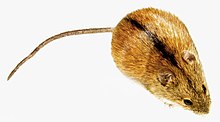Synonyms
Accepted synonyms include Apodemus albostriatus (Bechstein, 1801), Apodemus caucasicus (Kuznetzov, 1944), Apodemus chejuensis (Johnson and Jones, 1955), Apodemus coreae (Thomas, 1908), Apodemus gloveri (Kuroda, 1939), Apodemus harti (Thomas, 1898), Apodemus henrici (Lehmann, 1970), Apodemus insulaemus (Tokuda, 1939 and 1941), Apodemus istrianus (Kryštufek, 1985), Apodemus kahmanni (Malec and Storch, 1963), Apodemus karelicus (Ehrström, 1914), Apodemus maculatus (Bechstein, 1801), Apodemus mantchuricus (Thomas, 1898), Apodemus nicolskii (Charlemagne, 1933), Apodemus nikolskii (Migouline, 1927), Apodemus ningpoensis (Swinhoe, 1870), Apodemus ognevi (Johansen, 1923), Apodemus pallescens (Johnson and Jones, 1955), Apodemus pallidior (Thomas, 1908), Apodemus pratensis (Ockskay, 1831), Apodemus rubens (Oken, 1816), Apodemus septentrionalis (Ognev, 1924), Apodemus tianschanicus (Ognev, 1940) and Apodemus volgensis (Kuznetzov, 1944). [2]
Distribution and habitat
The striped field mouse has an extensive but disjunct distribution, split into two ranges. The first reaches from central and eastern Europe to Lake Baikal (Russia) in the north, and China in the south. The second includes parts of the Russian Far East and from there reaches from Mongolia to Japan. Its expansion across Eastern Europe appears to be relatively recent; the species is thought to have reached Austria in the 1990s. [4]
The striped field mouse inhabits a wide range of habitats including the edges of woodlands, grasslands and marshes, pastures and gardens, and urban areas. [4] In the winter, it may be found in haystacks, storehouses, and dwellings. [3]
Ecology
The striped field mouse excavates a short burrow with a nesting chamber at a shallow depth. It is nocturnal during the summer, but mainly diurnal in the winter. Its diet varies and includes green parts of plants, roots, seeds, berries, nuts, and insects. Three to five broods are born in a year with an average of six young per litter and the population can build up rapidly in a good season. Limiting factors include frequent torrential rains during a warm season, early soil freezing, and predation. [3]
This page is based on this
Wikipedia article Text is available under the
CC BY-SA 4.0 license; additional terms may apply.
Images, videos and audio are available under their respective licenses.



